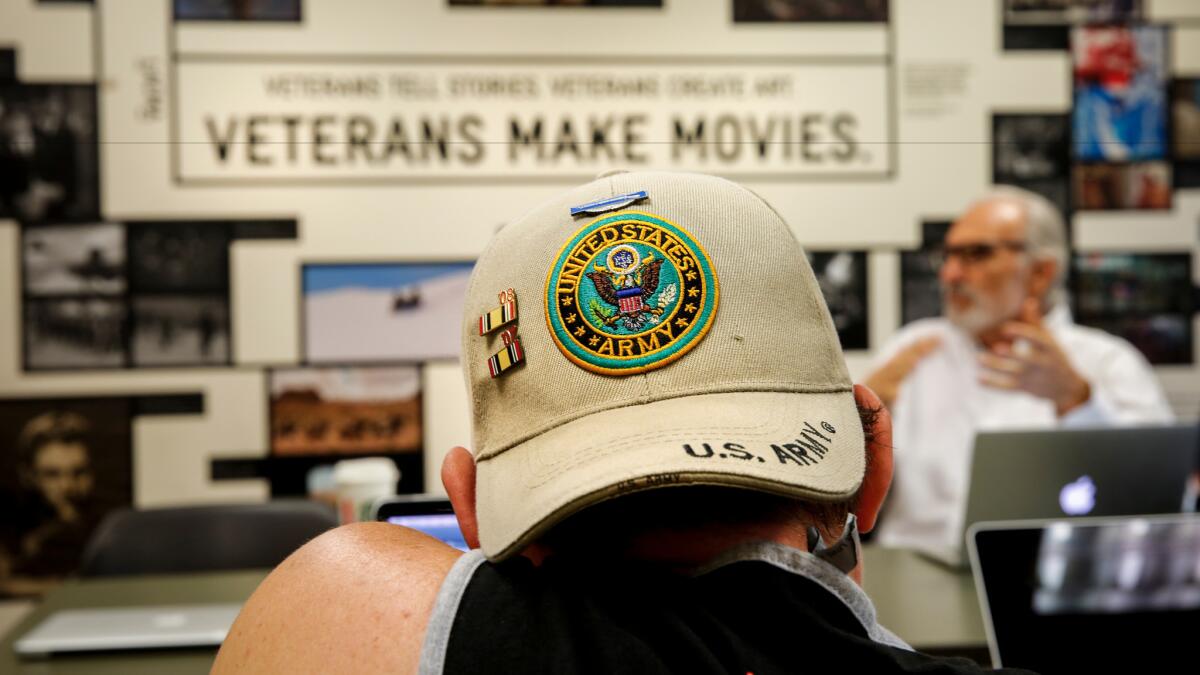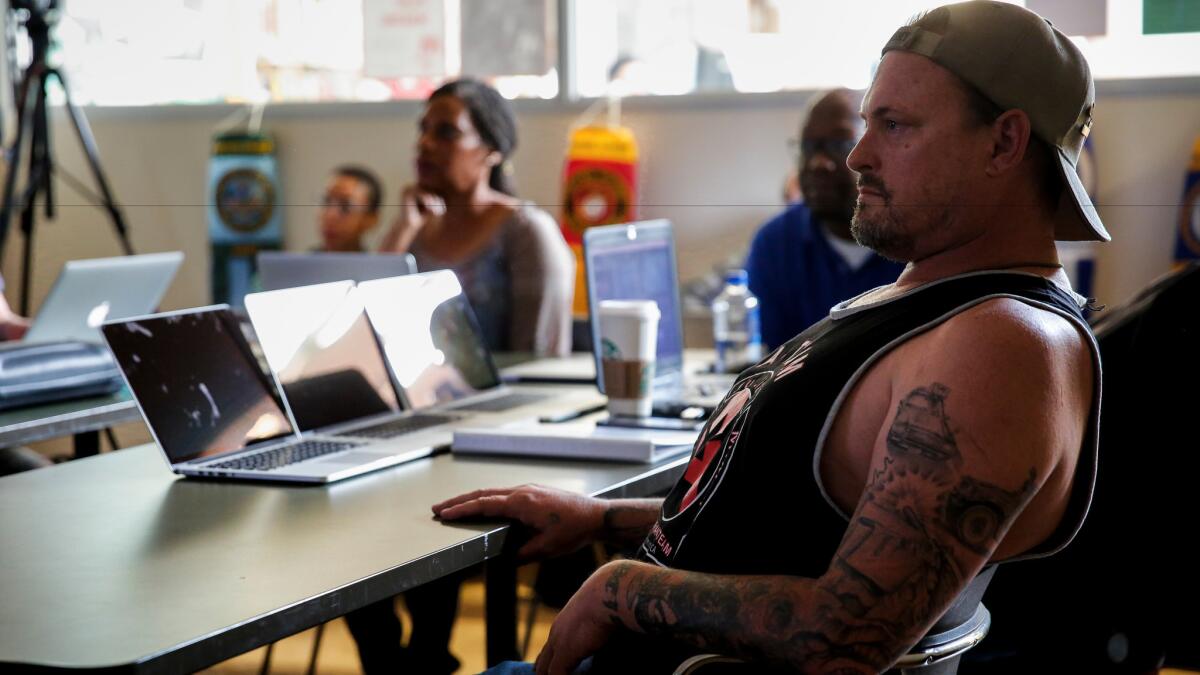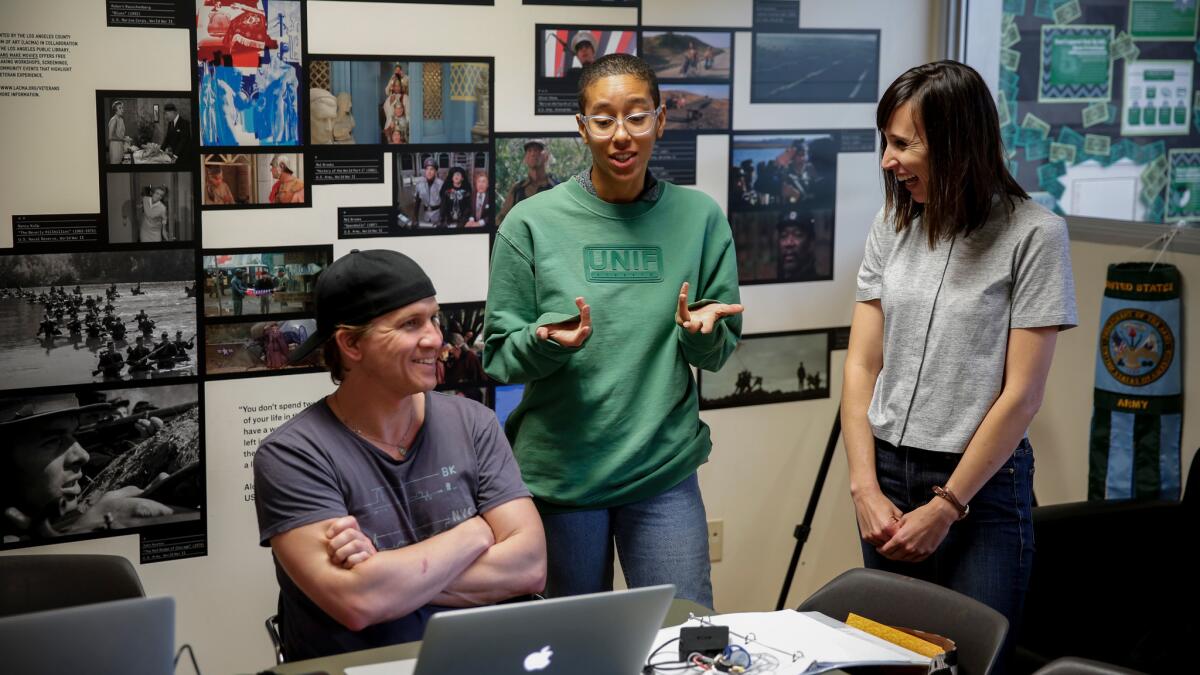Veterans Make Movies wants us to see an invisible population, the less than 1% of Americans who serve

Class begins with the arrival of cookies — a tray of chocolate chip discs dressed up like google-eyed spiders in honor of Halloween. They are brought by Leif Meisinger, an Army combat veteran who served in Iraq but who, decked out in Dickies and a pair of sleeve tattoos, still bears the brash skate punk aura of his Orange County youth.
“My girlfriend made cookies!” he announces as eight other students, all veterans, stream into a small meeting room at the Mary Bethune Regional Library in Exposition Park on a sunny Saturday afternoon.
There’s the gentlemanly Steve Fisch, who served for decades in the Navy, and the personable Mark Diaz, a former Marine. Also at the conference table, topped with bright new laptops, are Patrick Mulderrig, Heather Wick, Sean Ward, Kim Sykes and Chandus Jackson, veterans who have served in the military through war and peace.
They have gathered at the library’s Veterans Resource Center not for career or medical advice, but for something else entirely: to make movies.

Wick, a slim, graceful woman with silky white hair and a slight Southern accent, is exploring a veteran’s suicide in her piece — “but we are approaching it lightly,” she tells the class, “not so much on his death per se, as her life after.”
Ward is shooting a film about the architecture of downtown Los Angeles, but the drone he is using is giving him all kinds of technical headaches. “It won’t take off,” he explains. “Or it might land in the middle of the street.”
Jackson was making a documentary about veteran homelessness, but his source stopped cooperating. “I went to interview him and he clammed up — even though he was fine with it initially,” he says. “I respect that. But the thought is I will have to change course.”
For much of 2016, the Los Angeles County Museum of Art has funded and staffed free filmmaking workshops for veterans.
This weekend LACMA is showing some of the best shorts produced through the program at an event to be attended by Norman Lear — the television producer (and World War II Army vet) behind “All in the Family,” “The Jeffersons” and other classic sitcoms.
“Less than 1% of the population is enlisted,” says Sarah Jesse, who oversees the Veterans Make Movies program for LACMA. “Military life is invisible to most people. A lot of people don’t personally know anyone who has served. There is this civilian/veteran divide.”
Each Veterans Make Movies class is an intensive three hours led by a teacher with military experience, as well as a civilian teacher and a peer mentor, who is available to provide all manner of hands-on help. The program supplies cameras, computers and other gear. Students are expected to produce a short film by the end of each eight-week session.
This particular session is led by Shawn Spitler, an independent writer and director who has also served as a Marine combat photographer, and Tuni Chatterji, a filmmaker who recently completed a documentary about boatmen’s songs in Bangladesh. Cosmos Kiindarius, a Navy combat veteran who recently released his first feature film, a thriller called “Stand,” is on hand to help with everything from storyboarding to audio issues to narrative arcs.
“Some people just want to make a thing — unrelated from their veteran experience,” Spitler says. “Some are finding something deeply emotional when were serving or transitioning out and are trying to form that into an expression filmically.”
But their experiences in the military tie them together.
“The thing they all say is that we may all be very different, but we all have this in common,” Kiindarius says. “They’ve been very supportive of each other.”
This is about you ... you guys telling your story.
— Filmmaker and Veterans Make Movies instructor Tuni Chatterji
The lights dim as participants prepare to present what they have gathered since the last time the class met. Ward displays a slideshow of still imagery of Los Angeles — which includes a gleaming view of the Broad museum that draws several ahs.
Fisch, who served in a combat camera group in the Pacific during the Vietnam War, shows a snippet of a two-way interview he filmed for his project, about the children of military parents. He pauses the footage to provide a little background on one of his subjects.
“There’s a story here that she tells about her father, that his second wife finds a picture in his wallet after he dies and it’s of a Vietnamese lady,” Fisch says. “And at the funeral, one of the pallbearers, who had actually loaded ammunition on the plane in Vietnam with him, he knew the woman. What we learn through the 8-millimeter footage is that he was happy then. But then he came back and he was unhappy. He was pining for this woman.”
A few “wows” emerge from the table as everyone ruminates on the idea that there was a man who fell in love in war and was then forced to leave that love behind.
Diaz doesn’t have footage to present, but he reads a script that will serve as narration for his project. His film is autobiographical, telling the story of his troubled youth, in a gang-ridden patch of Santa Monica in the 1980s, with a “barroom brawler” father who was also “a charming womanizer.”
“By the age of 5 years old,” he reads — quickly, with a touch of nervousness, “all my brothers were already in the prison system.”
The story builds to the spiritual awakening that led him to enlist in the Marine Corps, where he served successfully for seven years.
“That is really well-written,” says Chatterji, once Diaz finishes, as the class nods in agreement. “It will be interesting to think about how you will be visualizing that.”

Then it’s Meisinger’s turn. He plugs his laptop into the television and presents the footage he has gathered. He appears squarely on camera, looking chastened, explaining the chain of events that led him to sign up for the Army — events that included financial problems and a failing marriage.
“One day I heard a radio ad saying they’d raised the age to 42 and there was a $20,000 sign-up bonus,” he says into the camera.
“It was time to go to war and I couldn’t look more forward to it,” he continues. “I was the perfect soldier because I didn’t care what happened.”
The room is quiet as the clip ends and the lights come on.
“First of all, this is amazing,” Spitler says. “When you pause, I can totally get what you’re pausing about. You don’t have to show something graphic to affect me.”
“I was going to talk about it instead,” responds Meisinger with a slight quiver in his voice. “The fact that I blew this guy’s head off, blew up this innocent civilian.”
Wick, across the table, pipes in. “It’s inside of you,” she tells him encouragingly. “Whatever you suffered, it’s inside of you. You can’t look away.”
“It’s weird to hear this,” says Meisinger, sounding relieved. “I was like, ‘They’re not gonna like it.’”
“This is about you,” interjects Chatterji, “you guys telling your story.”
The presentations wrap up and the instructors call for a 10-minute break. The mood lightens, but the intensity of the intimacies shared still linger in the air.
Meisinger picks up the baking tray and begins to proffer cookies like cocktail-party hors d’ouvres: “Cookie? Cookie?”
They are deliciously moist and sweet.
+++
Veterans Make Movies Screening
What: Veterans in the Arts and Humanities Day: Celebration and film screening with special guest Norman Lear
When: Sunday at 1 p.m.
Where: LACMA, Bing Theater, 5905 Wilshire Blvd.
Admission: Free
Info: lacma.org
Sign up for our weekly Essential Arts & Culture newsletter »
Find me on Twitter @cmonstah.
More to Read
The biggest entertainment stories
Get our big stories about Hollywood, film, television, music, arts, culture and more right in your inbox as soon as they publish.
You may occasionally receive promotional content from the Los Angeles Times.










